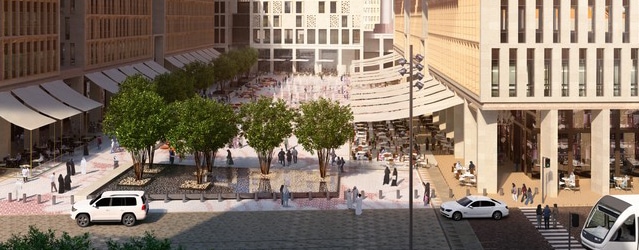The world's richest country seeks to create a regional hub to compete with the world's leading financial centers.

Qatar has begun construction of a new financial city, Msheireb Downtown Doha, which aims to be the country’s Wall Street or Canary Wharf and will ultimately have more than 100 buildings. In addition to financial and commercial enterprises, the $5 billion urban renewal project will include government buildings, residential properties, heritage sites, museums, a national archive and an Eid prayer ground.
The Qatar Financial Center will move to the new city, and new QFC-licensed firms will be able to operate from there beginning in mid-2017. “Through this relocation, we are taking a giant leap forward on the path of economic diversification,” says Yousef al-Jaida, chief executive of the QFC. Qatar’s Vision 2030 economic development blueprint articulates “the need for the creation of a stimulating business climate capable of attracting foreign funds and technologies and encouraging national investments,” he says.
The new city will be open to all businesses, foreign and domestic, and not just QFC-licensed firms. Existing firms may begin to relocate there starting in 2018. Msheireb Downtown will offer 100% foreign ownership and a 10% tax rate on locally sourced profits. Outside of Qatar’s special economic zones, foreign firms must have a local partner and are limited to 49% ownership.
The developer, Msheireb Properties, is a subsidiary of the Qatar Foundation for Education, Science and Community Development. “Msheireb Downtown is distinguished by its high-tech infrastructure and smart-city solutions, with state-of-the-art technology that integrates multiple information and communication systems required in the financial sector,” says Abdulla Hassan Al-Mehshadi, CEO of Msheireb Properties. “It also revives the history of the Msheireb area, which has always been a major center of business and trade.”
Not everyone is convinced, however, of the need for another new financial district in the region. Jason Tuvey, Middle East economist at Capital Economics in London, says he is skeptical that Downtown Doha and other rising financial hubs in Riyadh and Abu Dhabi will be all that successful. It could be difficult for the newcomers to attract a critical mass of major international financial institutions at a time when many banks are consolidating their global operations. “Dubai has already captured that market,” Tuvey says.
|
Central Bank: Qatar Central Bank | |||
|
International Reserves |
$36,923.4 billion | ||
|
Gross Domestic Product (GDP) |
$185.4 billion* | ||
|
Real GDP Growth |
2013 13.0% |
2014 6.1% |
2015* 6.5% |
|
GDP Per Capita—Current Prices |
$76,576* | ||
|
GDP—Composition By Sector* |
agriculture: 0.1% |
industry: 55.7% |
services: 44.1% |
|
Inflation |
2013 3.1% |
2014 3.3% |
2015* 1.7% |
|
Public Debt (general government |
2013 32.6% |
2014* 32.6% |
2015* 35.8% |
|
Government Bond Ratings (foreign currency) |
Standard & Poor’s AA |
Moody’s Aa2 |
Moody’s Outlook NEG |
|
FDI Inflows |
2013 $840 million |
2014 $1,040.4 million |
2015 $1,070.9 million |



